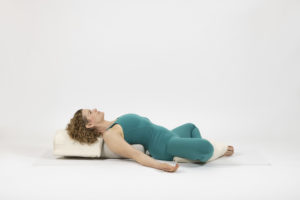
by Nina
Since Leza Lowitz has completed her wonderful series on restorative yoga poses, I thought it would be a good time to collect all the articles we have on restorative yoga into one post. I’ll start this article with some new background about restorative yoga and then provide links to: other articles on restorative yoga in general, posts on how to practice individual restorative poses, and featured restorative yoga sequences. Good news is that this fall Leza will be sharing some new restorative sequences that include the individual poses she wrote about earlier this year.
For those of you who are not familiar with restorative yoga, in restorative yoga poses you use props to support yourself in the shape of a classic yoga pose so you can be completely comfortable and relax completely, rather than feeling stretching sensations or muscular activity. For example, in Supported Child’s pose, rather than folding forward all the way onto the floor, you use a bolster or stack of folded blankets to support your entire front body. That being said, for some of the poses that Leza teaches, there is actually some gentle stretching that occurs. In these cases, the poses are good for releasing muscle tension while you are relaxing
The repertoire of restorative poses includes supported versions of classic reclined poses, forward bends, backbends, twists, and inverted poses. You can practice a single pose—Supported Reclined Cobbler’s pose is a favorite choice—or include poses at the end or the beginning of an active practice, or even practice an entire sequence of restorative poses.
When to Practice Restorative Yoga
You can practice restorative yoga any time you wish, morning, noon, or night. You can even practice in bed when you’re sick or injured. Some people even find it helpful to practice restorative poses, such as Child’s pose, in the middle of the night when they’re having trouble sleeping.
If you want to combine restorative poses with active yoga poses, typically the restorative poses would come at the end before the final Savasana. But if you’re feeling fatigued you could begin with a restorative pose and then slowly ease into more active poses.
How to Practice Restorative Yoga
It’s worthwhile to prepare for practicing restorative yoga. I suggest that before you set up your props, you start by creating a peaceful environment in the room where you are going to practice and change into clothes that will allow you to be comfort- able and warm.
To create a peaceful environment, clear enough space in the room or on the bed so when you practice, you won’t bump into furniture or stray objects, and dim any bright lights. To dress for the practice, if the weather is cool, add extra layers over your yoga clothes, such as a sweater or shawl, because you’ll cool down when you stay still, and consider wearing socks as well. You can also use a quilt or blanket to cover yourself after you’re in the pose, whether for extra warmth or just for added comfort.
Now you’re ready to set up your props. Because restorative yoga is all about being completely comfortable, the way you choose your props and the way you arrange them is important. So take the time to align your props symmetrically, and if you are using folded blankets, take care to fold them so there are no wrinkles, lumps, or uneven spots. Then, after you lie down in the pose, if you are not completely comfortable—if you feel muscles stretching or there is any physical discomfort—see if you can figure out how to change your props to make the pose work for you. And if you don’t have the right props, you can use household objects such as books for blocks, towels for blankets, and bathrobe sashes for yoga straps instead.
When you are finally comfortable, you can choose whether or not to close your eyes. Closing your eyes helps you withdraw your sense of vision. However, if it makes you feel anxious or causes a downward spiral of depressive thoughts, you can practice with your eyes open. When you do practice with eyes open, try softening your gaze and looking slightly downward so that you don’t take in a lot of visual information about your surroundings.
If you’re feeling anxious or vulnerable, prone poses (on your belly), such as Supported Child’s pose, can be especially comforting. But if the pose alone doesn’t provide the comfort or relaxation that you’re seeking, try using a mental focus. Using a mental focus helps you stay present in the pose, which allows you to experience conscious relaxation rather than being swept away by regrets over the past, worries about the future, or judgments about the present. It helps you stay alert in the pose so you don’t fall asleep. And it signals your nervous system that you’re now in safe circumstances, which may help you relax more completely.
Options include:
- Progressively relaxing individual parts of your body (sometimes called a body scan), usually starting with your toes and working your way up your body.
- Practicing breath awareness
- Silently reciting a mantra
- Picturing any peaceful image, such as a beautiful place in nature or place where you felt relaxed and happy.
General Posts About Restorative Yoga
Restorative Yoga: An Introduction
The Importance of Containment for Restorative Yoga
Why You Should Care About Your Recticular Activating System
Interview with Anna Ashby About Restorative Yoga
Posts About Individual Restorative Yoga Poses
Posts with Restorative Sequences
Restorative Yoga and Journaling to Welcome the New Year
With more to come this fall!
• Follow Yoga for Healthy Aging on Facebook and follow Nina on Instagram • Order Yoga for Times of Change here and purchase the companion videos here • Order Yoga for Healthy Aging: A Guide to Lifelong Well-Being here.


Leave A Comment